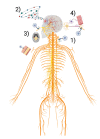Approximations to Diagnosis and Therapy of COVID-19 in Nervous Systems Using Extracellular Vesicles
- PMID: 36558835
- PMCID: PMC9782638
- DOI: 10.3390/pathogens11121501
Approximations to Diagnosis and Therapy of COVID-19 in Nervous Systems Using Extracellular Vesicles
Abstract
The SARS-CoV-2 virus was first identified at the end of December 2019, causing the disease known as COVID-19, which, due to the high degree of contagion, was declared a global pandemic as of 2020. The end of the isolation was in 2022, thanks to the global multidisciplinary work of the massive vaccination campaigns. Even with the current knowledge about this virus and the COVID-19 disease, there are many questions and challenges regarding diagnosis and therapy in the fight against this virus. One of the big problems is the so-called "long COVID", prolonged symptomatology characterized as a multiorgan disorder manifested as brain fog, fatigue, and shortness of breath, which persist chronically after the disease resolution. Therefore, this review proposes using extracellular vesicles (EVs) as a therapeutic or diagnostic option to confront the sequelae of the disease at the central nervous system level. Development: the review of updated knowledge about SARS-CoV-2 and COVID-19 is generally addressed as well as the current classification of extracellular vesicles and their proposed use in therapy and diagnosis. Through an analysis of examples, extracellular vesicles are highlighted to learn what happens in the central nervous system during and after COVID-19 and as a therapeutic option. Conclusions: even though there are limitations in the knowledge of the neurological manifestations of COVID-19, it is possible to observe the potential use of extracellular vesicles in therapy or as a diagnostic method and even the importance of their study for the knowledge of the pathophysiology of the disease.
Keywords: COVID-19; SARS-CoV-2; diagnostic; extracellular vesicles (EVs); therapy.
Conflict of interest statement
The authors declare no conflict of interest.
Figures


Similar articles
-
COVID-19 and Extracellular Vesicles: An Intriguing Interplay.Kidney Blood Press Res. 2020;45(5):661-670. doi: 10.1159/000511402. Epub 2020 Sep 21. Kidney Blood Press Res. 2020. PMID: 32957112 Free PMC article. Review.
-
Neurological Sequelae of COVID-19.J Integr Neurosci. 2022 Apr 6;21(3):77. doi: 10.31083/j.jin2103077. J Integr Neurosci. 2022. PMID: 35633158 Review.
-
Investigation of Extracellular Vesicles From SARS-CoV-2 Infected Specimens: A Safety Perspective.Front Immunol. 2021 Apr 22;12:617042. doi: 10.3389/fimmu.2021.617042. eCollection 2021. Front Immunol. 2021. PMID: 33968019 Free PMC article.
-
Extracellular Vesicles Analysis in the COVID-19 Era: Insights on Serum Inactivation Protocols towards Downstream Isolation and Analysis.Cells. 2021 Mar 4;10(3):544. doi: 10.3390/cells10030544. Cells. 2021. PMID: 33806297 Free PMC article.
-
Emerging roles of extracellular vesicles in COVID-19, a double-edged sword?Immunology. 2021 Aug;163(4):416-430. doi: 10.1111/imm.13329. Epub 2021 May 4. Immunology. 2021. PMID: 33742451 Free PMC article. Review.
References
-
- Soltani S., Tabibzadeh A., Zakeri A., Zakeri A.M., Latifi T., Shabani M., Pouremamali A., Erfani Y., Pakzad I., Malekifar P., et al. COVID-19 associated central nervous system manifestations, mental and neurological symptoms: A systematic review and meta-analysis. Rev. Neurosci. 2021;32:351–361. doi: 10.1515/revneuro-2020-0108. - DOI - PubMed
Publication types
LinkOut - more resources
Full Text Sources
Miscellaneous

